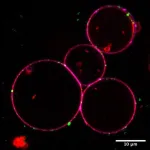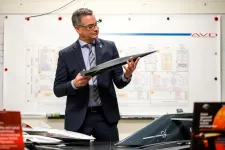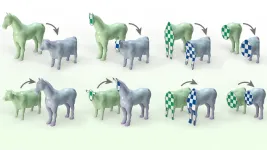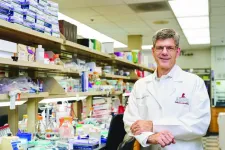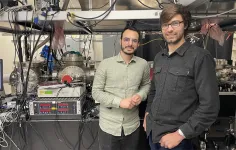(Press-News.org) Research question
Can these contributions to standing postural control be quantified from CoP trajectories in neurotypical adults?
Methods
Instantaneous contributions can be negative or larger than one, and integrated contributions sum to equal one. Proof-of-concept demonstrations validated these calculated contributions by restricting CoP motion under one or both feet. We evaluated these contributions in 30 neurotypical young adults who completed two (eyes opened; eyes closed) 30-s trials of bipedal standing. We evaluated the relationships between limb contributions, self-reported limb dominance, and between-limb weight distributions.
Results
All participants self-reported as right-limb dominant; however, a range of mean limb contributions were observed with eyes opened (Left: mean [range] = 0.52 [0.37–0.63]; Right: 0.48 [0.31–0.63]) and with eyes closed (Left: 0.51 [0.39–0.63]; Right: 0.49 [0.37–0.61]). Weight-shift contributions were small with eyes opened (0.00 [−0.01 to 0.01]) and eyes closed (0.00 [−0.01 to 0.02]). We did not identify any between-limb differences in contributions when grouped by self-reported limb dominance (p > 0.10, d < 0.31). Contributions did not significantly correlate with Waterloo Footedness scores (−0.22 < r < 0.21, p > 0.25) or between-limb weight distributions (0 < r < 0.24, p > 0.20).
Significance
Across neurotypical participants, we observed a notable range of limb contributions not related to self-reported limb dominance or between-limb weight distributions. With this tool, we can characterize differences in the amount of CoP motion and the underlying control strategies. Changes in limb contribution can be measured longitudinally (i.e., across rehabilitation programs, disease progression, aging) representative of limb function, which may be particularly useful in populations with asymmetric function.
Introduction
Postural sway is often quantified from center-of-pressure (CoP) trajectories during quiet standing. Anteroposteriorly, destabilizing gravitational forces are countered with ankle plantar- and dorsiflexor moments—the primary postural control mechanisms during quiet stance—resulting in CoP movement underneath each foot [1], [2], [3], [4], [5]. Understanding how individual limbs contribute to this standing postural control as measured using the CoP is of particular interest when evaluating populations with asymmetric function (e.g., stroke, amputations) where net CoP measures may overlook differences. For example, persons with Parkinson’s disease, who demonstrate asymmetric limb function and standing stability [6], may not show significant differences in standing postural control early in disease progression when characterized by traditional net center of pressure analysis, but do in later stages [7]. Previous efforts comparing the CoP between limbs showed both similarities and differences in the spatial and frequency domains, correlations to net CoP, and between-limb synchrony [2], [3], [5], [8], [9], [10]. However, these approaches did not quantify how each limb, and weight shifting, contributed to anteroposterior CoP control. Therefore, these previous methods ignored relevant biomechanical CoP control strategies.
The purpose of this analysis was to (1) validate a novel measure of standing anteroposterior CoP control and (2) assess the relationship between this measure and common limb dominance characterizations. We hypothesized that (1) our novel measure would be valid evidenced by proof-of-concept trials targeting each variable, and (2) limb contributions would be distinct from limb dominance.
Proof-of-concept results
The unrestricted condition showed asymmetric and consistent contributions from each limb, with small weight-shift contributions (Fig. 2A). With one limb restricted, the unrestricted limb was the primary contributor (Fig. 2B and C). With both limbs restricted, weight shifting was the primary contributor (Fig. 2D).
Exploratory results
Eyes-opened results are shown in Fig. 3. Eyes-closed results and a correlation matrix are provided in the Supplementary material. Across neurotypical participants, we observed a notable
Conclusion
These results validate our novel calculation of limb contributions to standing anteroposterior postural control. Our conclusions and variable contributions were consistent between eyes-opened and eyes-closed conditions. However, these contributions did not appear to be related to self-reported limb dominance (i.e., kicking limb and Waterloo Footedness) or between-limb weight distributions. Self-reported limb dominance has also poorly identified the preferred landing limb for young adults.
END
A novel method to quantify individual limb contributions to standing postural control
2023-05-24
ELSE PRESS RELEASES FROM THIS DATE:
NASA data could lead to more accurate weather forecasts
2023-05-24
A University of Texas at Arlington civil engineering researcher will use a NASA grant to help forecasters better predict extreme weather events using a variety of existing NASA data sources.
Yu Zhang, associate professor in the Department of Civil Engineering, said the $638,000 grant will use ocean circulation data, atmospheric conditions and current weather information to make longer-range forecasting more reliable. Having a more accurate forecast could help officials make better decisions about the state’s water resources—for example, knowing when to release water from reservoirs.
“Using ...
Digital engineering to reduce risks that lead to brain injuries
2023-05-24
A University of Texas at Arlington engineering researcher who studies traumatic brain injuries has received funding to use computer motion simulation that replicates the movements of a person performing activities that could lead to injury.
The project, funded by a nearly $1 million grant from the Office of Naval Research Defense University Research Instrumentation Program (DURIP), will use real-time data of phantom head and phantom body reactions to ascertain what physical injuries could come from those motions.
Ashfaq Adnan, a UT Arlington professor in the Department of Mechanical and Aerospace Engineering, is leading the project, called “System for Remote ...
A look into the heart of cellular waste disposal
2023-05-24
To prevent our body’s cells from overflowing with garbage and to keep them healthy, the waste inside them is constantly being disposed of. This cleaning process is called autophagy. Scientists have now, for the first time, rebuilt the complex nanomachine in the laboratory that starts this process – and it works quite differently from other cellular machines. The researchers’ new insights could help open up new approaches for the treatment of cancer, immune disorders, and neurodegenerative diseases in ...
Designing a next generation hypersonic demonstrator
2023-05-24
Today, large commercial jets fly around 580 mph. The Lockheed SR-71 Blackbird introduced in 1966 is the fastest supersonic jet vehicle in the world, reaching speeds of more than 2,200 mph, nearly four times faster than a commercial jet.
The fastest rocket-powered hypersonic vehicle developed in the late 1960s carrying a human has been the North American X-15, reaching a top speed of 4,520 mph, twice that of the SR-71.
Recently, the U.S. Air Force has awarded a contract to engineer Project Mayhem with the goal to reach 4,603 mph. Now, imagine a vehicle that could fly much faster, maybe even above 6,905 mph, which is beyond nine times the speed of sound.
The University of Texas at Arlington’s ...
Confusion over VAERS: Why the vaccine safety reporting system should be renamed
2023-05-24
PHILADELPHIA – The federal health system for reporting “adverse events” after vaccination, known as VAERS, is designed to assist in the early detection of complications and responsive action. But when the pandemic and advent of new vaccines for Covid-19 turned a spotlight on this formerly little-known system, the flood of web and social media references to it was accompanied by confusion about what the system is and what the reports in it signify.
A new report from the Annenberg Public Policy Center examines misconceptions about the government’s Vaccine Adverse ...
A better way to match 3D volumes
2023-05-24
CAMBRIDGE, MA — In computer graphics and computer-aided design (CAD), 3D objects are often represented by the contours of their outer surfaces. Computers store these shapes as “thin shells,” which model the contours of the skin of an animated character but not the flesh underneath.
This modeling decision makes it efficient to store and manipulate 3D shapes, but it can lead to unexpected artifacts. An animated character’s hand, for example, might crumple when bending its fingers — a motion that resembles how an empty rubber glove deforms rather than the motion of a hand filled with bones, tendons, ...
Chemical Insights Research Institute and the Campus Safety, Health, and Environmental Management Association publish guidance for the safe use of 3D printing in institutions of higher education
2023-05-24
Atlanta (May 24, 2023) - Chemical Insights Research Institute (CIRI) of UL Research Institutes and the Campus Safety, Health, and Environmental Management Association (CSHEMA), announce the publication of, “UL 200B: Guidance Document for Safe Use of 3D Printing for Institutions of Higher Education.”
The availability of 3D printing has fostered creative and innovative learning experiences for many within the large population of students in higher education. There are roughly 17.3 million undergraduates in the U.S. alone. Because 3D printers are affordable compact, and user friendly, they can ...
SWI/SNF complexes “bookmark” cell identity during division
2023-05-24
(Memphis, Tenn.—May 24, 2023) When a cell divides, it retains information about how to grow and instructions about what type of cell to become. Scientists at St. Jude Children’s Research Hospital have gained a new understanding of how these processes can work, revealing a previously unappreciated role for the SWI/SNF chromatin remodeling complex. The study was published today in Nature.
When a cell undergoes differentiation, stem cells (the earliest cells that develop) undergo changes that transform them into a different type of cell, typically one with a more specialized function (such as a skin or muscle cell). As ...
Watching molecules relax in real time
2023-05-24
– By Rachel Berkowitz
Designing the next generation of efficient energy conversion devices for powering our electronics and heating our homes requires a detailed understanding of how molecules move and vibrate while undergoing light-induced chemical reactions. Researchers at the Department of Energy’s Lawrence Berkeley National Laboratory (Berkeley Lab) have now visualized the distortions of chemical bonds in a methane molecule after it absorbs light, loses an electron, and then relaxes. Their study provides insights into how molecules react to light, which can ultimately be useful for developing new methods ...
Announcing the Johnson & Johnson nursing innovation fellows
2023-05-24
PHILADELPHIA (May 24, 2023) – The University of Pennsylvania School of Nursing is pleased to announce that ten teams from health systems around the country have been selected for the Johnson & Johnson Nurse Innovation Fellowship Program (JJNIF), powered by Penn Nursing and the Wharton School–a ground-breaking, one-year, team-based nursing fellowship for Chief Nursing Officers, nurse executives, and senior nurse leaders.
The fellowship is unique in that two nurse leaders – one Chief Nursing Officer or nurse executive and one other senior ...


